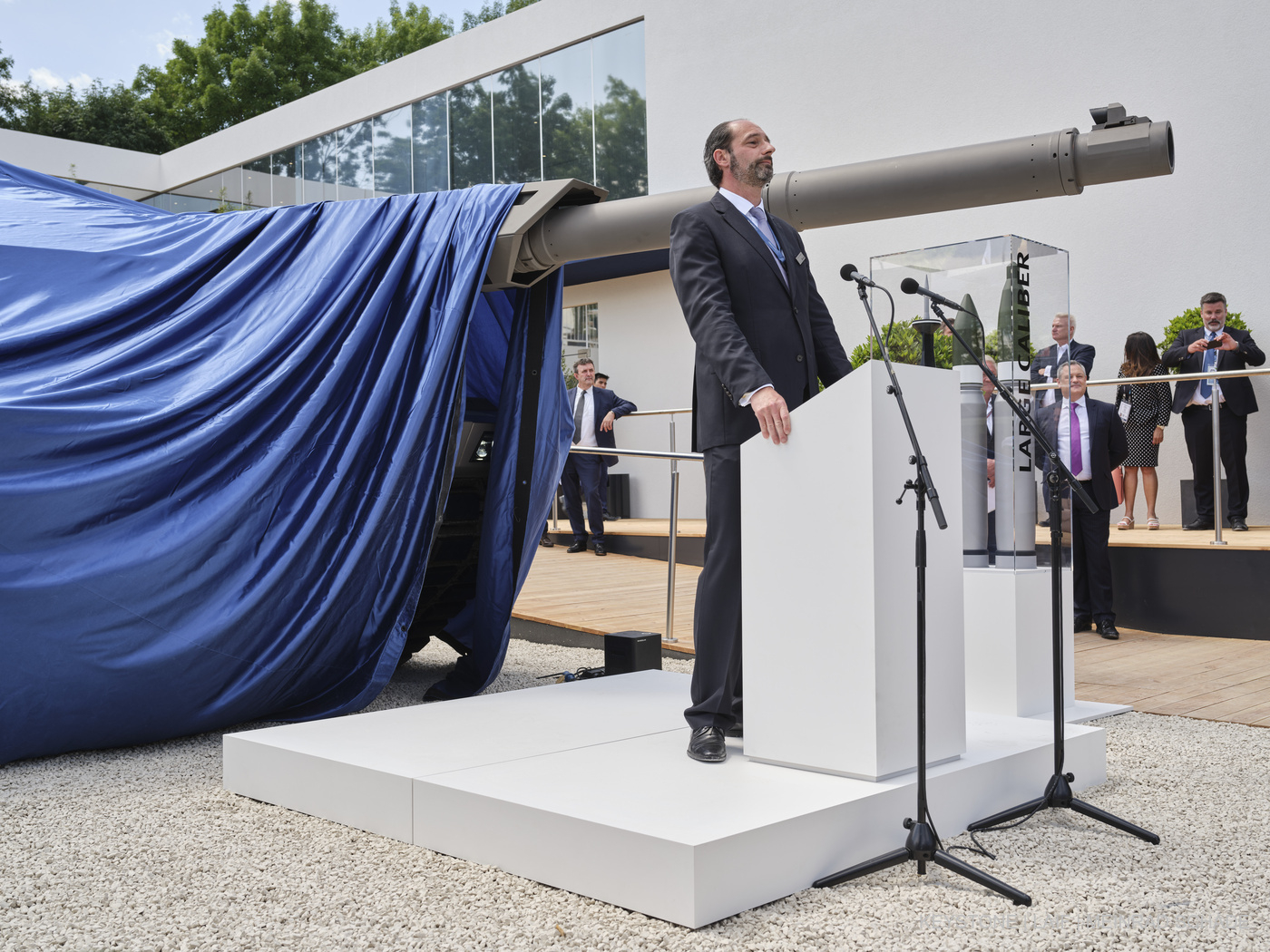Share post now

global
The Alliance Sud magazine analyses and comments on Switzerland's foreign and development policies. "global" is published four times a year (in german and french) and can be subscribed to free of charge.
Military build-up instead of development
30.09.2025, Financing for development
Instead of long-term planning and investments in sustainability, defence spending is being boosted – and massively. What are the broader implications for poverty alleviation, climate funding and sustainable development? An analysis.

Achieving peace with weapons? Rheinmetall spokesman Philipp Freiherr von Brandenstein unveils a new tank at the Eurosatory defence exhibition. © Keystone/laif/Meinrad Schade
The war in Ukraine has severely impacted the sense of security in Europe and also in Switzerland – a Russian invasion in Europe seems possible. Whereas NATO could rely on the massive protective might of America until just recently, that certainty has been in ever greater decline since Donald Trump took office at the White House. In 2014, after Russia invaded Crimea, NATO countries decided to increase their military spending to 2 per cent of gross domestic product. In 2024, 23 of the 32 NATO member countries attained this goal (overall NATO military spending reached 1.47 billion, of which almost two-thirds fell to the USA). In June this year, NATO announced its intention to raise military spending to 5 per cent of GDP by 2035, which represents more than a doubling. But where is this money to come from, and can the global military build-up really guarantee peace?
If the 5 per cent target is really to be attained by 2035, the question arises as to how this massive spending increase is to be funded. Most NATO members currently have a relatively high level of public debt: while the United States has a debt ratio of about 120 per cent of GDP, the EU’s average debt ratio is 81.5 per cent of GDP. Consequently, several countries (including the USA, France and Italy) have seen their creditworthiness downgraded by individual rating agencies in recent years.
While military spending is being stepped up, many countries face looming cuts in other areas, including social security, climate protection and international cooperation. Between 2022 and 2023, 15 members of the OECD Development Assistance Committee (OECD-DAC) scaled back development funding, most of them while expanding their military budget. From 2024 to mid-2025, a further eight DAC members decided to reduce their development spending, in part so as to pay for rising military expenditure. Initial OECD estimates are that official development assistance could contract by as much as 17 per cent in 2025, and that this trend will continue in the years ahead. The internationally agreed target of allocating 0.7 per cent of Gross National Income (GNI) to development assistance is thus receding steadily into the distance (in 2024, the OECD average fell to 0.33 per cent, and without domestic spending on asylum, to a feeble 0.29 per cent of GNI).
In parallel, the climate crisis is ruining livelihoods throughout the world, and both Europe and the USA are experiencing extreme weather events ever more frequently. It will take billions to combat and adapt to climate change. Besides, there are some 123.2 million displaced people on the move around the world, 673 million starving people and roughly 305 million are in urgent need of humanitarian aid – the needs are growing, even as the available funds diminish. In the West, too, more and more people are finding it impossible to finance their living costs and have lost trust in politicians. The upshot is the rise of extremist, populist and illiberal politicians.
While the political will for military upgrading is beyond doubt, there are dwindling scruples about building up the army, at least in part, at the expense of social security, poverty alleviation or climate protection.
In Switzerland, too, the trend is similar. In late 2024, the Parliament decided to increase defence spending by four billion francs between 2025 and 2028, bringing it to 1 per cent of GDP (from the current 0.7 per cent) by 2032. At the same time, cuts were announced to international assistance worth 110 million francs for 2025 and 321 million francs for the 2026-2028 period. And the discussion on cost-cutting is not yet over: further economy measures in various social fields and in climate protection are up for debate this autumn in the framework of the ‘relief package’.
While the wisdom of a rapid military build-up is also open to study in Switzerland (especially as it is surrounded by NATO countries and a cyberattack is far more likely than an air attack in the current context), Switzerland has no debt problem compared to many of its European neighbours. Its debt ratio of 17.2 per cent is almost preposterously low compared to other countries, and cost-cutting measures in that context are entirely unnecessary. Even with a significantly higher debt ratio of 62.5 per cent, Germany recently decided to relax its much less stringent debt rules so as to allow for an extraordinary boost to defence spending and the creation of a 500-billion-euro special fund for infrastructure projects and climate change measures. Switzerland would therefore have considerable leeway to fund higher military expenditure, expanded international cooperation, social welfare and also climate protection. What is missing is the political will.
So, the world is rearming – and massively. Sweden’s Stockholm International Peace Research Institute (SIPRI) sees this as a landmark shift – away from the concept of security that has prevailed since the end of the Cold War, founded on arms control, confidence-building mechanisms and transparency, towards a security concept based on hard power and deterrence. According to SIPRI, massive defence spending may indeed deter potential aggressors, but does harbour the risk of accelerating an arms race and also of undermining attempts at dialogue, confidence-building mechanisms and possible new arms control agreements.1 Besides, warnings can be heard from many quarters about the appreciable risks of procurement inefficiencies, overpricing, misuse and the bypassing of oversight mechanisms. As has been repeatedly demonstrated over recent years, Switzerland is already well experienced in this regard.
A military build-up in Europe and Switzerland may seem to make sense in the light of current threat levels, but what is to be the medium-to-long-term fate of all the new weaponry now being produced (quite apart from the fact that the arms industry is highly dependent on the fossil fuels industry, which is now re-gaining in strength)? What will our world look like in 10 years, if climate protection, social security and international cooperation are being rapidly scaled back in order to promote militarisation?
It does not yet seem too late to invest in a comprehensive, holistic security concept that does not play military security off against social security, international assistance or international climate finance, but treats them all as equally important cornerstones of a comprehensive, long-term security policy.
Many security experts question the logic of a rapid military build-up, arguing that what is needed instead is better intra-European coordination and cooperation. Spain's Prime Minister Sanchez, too, underscored this by expressly rejecting the 5-per cent target, which he regards as unwise and counterproductive. He made clear that Spain is not prepared to make savings on welfare, international cooperation or the energy transition in order to hastily purchase off-the-shelf equipment from abroad and thereby exacerbate the problems of dependence on the USA and interoperability of European military equipment.
In parallel, every effort should be made at the domestic policy level to restore public trust in politicians. Investing in retirement provisions, social security and healthcare are just as integral to this endeavour as investing in the energy transition and environmental protection. At the foreign policy level, the commitment to multilateralism, diplomacy, climate funding and international cooperation should be strengthened, as the only way to guarantee long-term security is through cooperation, dialogue and the observance of international obligations for the common good. Spain and Germany are demonstrating that security policy can be conceived more broadly, rather than as something that they play off against each other. As a rich and relatively debt-free country, Switzerland could afford to join in this endeavour and lead the way.
1 START – the last remaining arms control agreement between Russia and the USA to limit strategic nuclear weapons – expires in 2026; currently, neither Russia nor the USA seems keen on extending that agreement. Besides, almost all nine nuclear States continued their intensive nuclear modernisation programme in 2024.
Share post now

global
The Alliance Sud magazine analyses and comments on Switzerland's foreign and development policies. "global" is published four times a year (in german and french) and can be subscribed to free of charge.